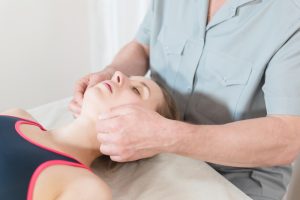TMJ Pain and Physical Therapy
January 16, 2024
Temporomandibular Joint (TMJ) pain is a common condition affecting millions of people worldwide. This discomfort often arises from issues with the jaw joint and surrounding muscles. While various factors can contribute to TMJ pain, including stress, teeth grinding, and arthritis, finding effective relief is crucial for enhancing quality of life. Physical therapy can provide help for managing and alleviating TMJ pain, offering non-invasive and tailored approaches to address the root causes.
The temporomandibular joint connects the jawbone to the skull and facilitates essential functions like chewing and talking. When this joint becomes dysfunctional or experiences strain, it can lead to TMJ pain. Symptoms may include jaw stiffness, clicking or popping sounds, difficulty opening or closing the mouth, and headaches. Physical Therapy can help identify the underlying causes and is crucial for devising an effective treatment plan.
Physical therapy plays a pivotal role in treating TMJ pain by addressing muscular imbalances, promoting joint mobility, and improving overall jaw function. Here are some key components of physical therapy for TMJ pain:

Manual Therapy Techniques
Skilled physical therapists employ hands-on techniques to manipulate and mobilize the jaw joint. Manual therapy helps release tension, improve flexibility, and restore proper alignment. This can significantly reduce pain and enhance jaw function.
Strengthening Exercises
Targeted exercises aim to strengthen the muscles surrounding the jaw. Strengthening these muscles can provide better support to the joint, reducing the likelihood of pain and dysfunction. Therapists often prescribe exercises that focus on the jaw, neck, and shoulder muscles.
Posture Correction
Poor posture can contribute to TMJ pain. Physical therapists assess and correct posture to ensure optimal alignment of the head, neck, and spine. Improved posture can alleviate stress on the jaw joint and associated muscles.
Educational Guidance
Patients receive valuable education on lifestyle modifications and self-care practices. This may include recommendations on proper jaw mechanics, diet adjustments, and strategies to prevent teeth grinding, which is a common contributor to TMJ pain.
TMJ pain can significantly impact an individual’s daily life, but effective relief is within reach through physical therapy. A comprehensive approach that combines manual therapy, exercises, posture correction, relaxation techniques, and patient education can provide lasting benefits. If you’re experiencing TMJ pain, consulting with a qualified physical therapist can be the first step towards regaining comfort and improving the overall health of your jaw joint. Remember, a personalized and holistic approach is key to successfully managing and alleviating TMJ pain.
References










